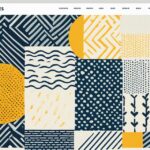Table of Contents
Motion Graphics Web has revolutionized the way we interact with websites, delivering immersive web experiences that captivate and engage users. By combining animation, transitions, and interactivity, motion design principles elevate the visual storytelling and user experience of a website.
Immersive web experiences have become increasingly important in the digital landscape, as users seek interactive user experiences that go beyond static content. Motion Graphics Web offers numerous benefits for web design projects, attracting attention, improving usability, expressing personality, and creating differentiation.
With Motion Graphics Web, websites can capture the user’s attention with dynamic visuals and animations. The motion enhances usability and feedback, providing intuitive cues and guiding users through the website. Through motion design, websites can express the personality and emotion of the brand, establishing a deeper connection with the audience.
Motion Graphics Web creates memorable and captivating experiences, leaving a lasting impression on the user. It allows websites to stand out from the competition, providing unique and engaging interactions that keep users coming back for more.
In the following sections, we will explore the benefits, principles, tools, and considerations of Motion Graphics Web in web design. By understanding the power and potential of motion design, you can take your web experiences to new heights, ensuring that your website becomes a memorable destination for users.
Benefits of Motion Design in Web Design
Motion design in web design projects offers a range of benefits that contribute to engaging and memorable web experiences. By incorporating motion design elements, websites have the ability to capture attention, enhance usability, express personality and emotion, and create differentiation.
Attracting Attention and Interest
Motion design has the power to grab the user’s attention and generate curiosity. By incorporating subtle animations or eye-catching transitions, websites can effectively communicate important messages and encourage users to explore further. The motion elements can serve as visual cues, guiding users through the interface and highlighting key information.
Enhancing Usability and Feedback
Motion design contributes to improving the usability and feedback of a website. Through smooth animations and transitions, users can navigate the interface seamlessly, creating a more intuitive and enjoyable experience. Motion elements can provide visual feedback, such as indicating button clicks or form submissions, enhancing user understanding and engagement.
Expressing Personality and Emotion
Motion design allows websites to express their personality and evoke emotion through visual storytelling. By incorporating animations that align with a brand’s tone and voice, websites can convey their unique identity and connect with users on an emotional level. This helps to establish a stronger brand presence and forge deeper connections with the target audience.
Creating Differentiation and Memorability
Motion design sets websites apart from the competition by creating differentiation and promoting memorability. By utilizing creative and unique motion elements, websites can leave a lasting impression on users, making them more likely to remember and revisit the site. Differentiating through motion design establishes a distinctive brand presence and enhances the overall user experience.
By leveraging the benefits of motion design in web design, websites can provide engaging web experiences that captivate users and leave a lasting impact. The combination of attention-grabbing animations, enhanced usability, and the expression of brand personality creates a holistic user experience that sets websites apart from the competition.
Principles of Motion Design in Web Design
Creating effective and meaningful motion design for web design projects requires following specific principles. By adhering to these principles, designers can ensure that motion elements enhance the user experience and align with the website’s goals and objectives.
- Clear Purpose: Motion design elements should have a clear purpose that supports the website’s goals and objectives. Whether it is to guide the user’s attention, emphasize important information, or provide visual feedback, every motion element should serve a specific purpose.
- Simple and Minimal: Keeping motion design simple and minimal is key to avoid overwhelming the user. By using clean and uncluttered motion, designers can create a visually pleasing and easy-to-comprehend experience.
- Elegant and Smooth: Motion elements should be elegant and smooth, with natural and realistic movement. By mimicking real-world physics and human behavior, the motion feels more intuitive and satisfying to the user.
- Delightful and Engaging: Incorporating delightful and engaging motion can add value to the user experience. Creative and surprising motion elements can entertain and captivate users, making the website more memorable and enjoyable.
- Avoid Abrupt or Jarring Motions: It is essential to avoid abrupt or jarring motions that disrupt the user’s flow and experience. By ensuring that transitions and animations are seamless and harmonious, designers create a smoother and more immersive web experience.
Following these motion design principles helps designers create visually appealing, engaging, and seamless web experiences. By incorporating purposeful and well-executed motion elements, websites can captivate users and leave a lasting impression.
| Motion Design Principles | Description |
|---|---|
| Clear Purpose | Motion design elements should have a clear purpose that supports the website’s goals and objectives. |
| Simple and Minimal | Motion design should be kept simple and minimal to avoid overwhelming the user. |
| Elegant and Smooth | Motion elements should have elegant and smooth movement, mimicking natural and realistic motion. |
| Delightful and Engaging | Motion elements should be delightful and engaging, adding value to the user experience. |
| Avoid Abrupt or Jarring Motions | Avoid using abrupt or jarring motions that disrupt the user’s flow and experience. |
Tools and Techniques of Motion Design in Web Design
To implement motion design on a website, various tools and techniques can be used. CSS is a common and widely supported tool for creating motion design effects using properties like transform, transition, and animation. JavaScript is another powerful tool that can be used to create more complex and interactive motion effects and animations, such as scrolling, parallax, hover, click, drag, or swipe. The Web Animation API is a native browser API that allows control over motion effects and animations using JavaScript. Motion design software like Adobe After Effects can also be used, along with keyframe animations and easing functions to achieve precise control and natural movements.
Table 4: Tools and Techniques for Motion Design in Web Design
| Tool | Description |
|---|---|
| CSS | A widely supported tool for creating motion design effects using properties like transform, transition, and animation. |
| JavaScript | A powerful tool for creating complex and interactive motion effects and animations, such as scrolling, parallax, hover, click, drag, or swipe. |
| Web Animation API | A native browser API that allows control over motion effects and animations using JavaScript. |
| Adobe After Effects | Motion design software that enables the creation of advanced visual effects and animations. |
| Keyframe Animations | Animation technique that defines different stages or keyframes of an object’s motion. |
| Easing Functions | Mathematical functions used to control the speed and acceleration of motion effects, creating smooth and natural movements. |
Using a combination of these tools and techniques, web designers can bring their motion design visions to life, enhancing the user experience and creating visually compelling websites. The flexibility and control provided by CSS, JavaScript, Web Animation API, and motion design software enable designers to craft dynamic and engaging animations that captivate users and effectively convey messages.
Considerations for Motion Graphics in Web Design
When incorporating motion graphics into web design, it is crucial to consider several factors to ensure a seamless user experience. Moderation and user controls play a vital role in preventing discomfort and allowing users to dictate their level of interaction with motion elements. Usability should always be a priority, with motion enhancing rather than distracting from the overall user experience.
To maintain a cohesive and polished look and feel, consistency in motion design across the website is essential. By utilizing consistent motion principles, such as speed, easing, and timing, users can navigate the website effortlessly, creating a more engaging and enjoyable experience.
It is equally important to test motion effects on different devices and screen sizes to ensure responsiveness. A responsive design ensures that motion graphics adapt seamlessly to various platforms and devices, providing users with optimal viewing experiences.
Lastly, staying informed about evolving trends in motion design allows designers to remain at the forefront of industry standards, providing users with fresh and modern experiences. By continuously learning and incorporating new techniques, designers can create innovative and visually stunning motion graphics that captivate and engage users.
Motion graphics in web design offer endless possibilities for enhancing user experiences when implemented with moderation, usability, consistency, responsiveness, and awareness of evolving trends.
Overall, when incorporating motion graphics into web design, considering user controls, usability, consistency, responsiveness, and staying up to date with evolving trends is paramount to creating captivating and immersive web experiences.
Tools and Resources for Motion Graphics Designers
Motion graphics designers have access to a variety of tools and resources to support their design process. Below is a list of some popular tools and platforms:
- Adobe After Effects: Adobe After Effects is the industry-standard tool for creating motion graphics and visual effects. It offers a wide range of features and functionalities that allow designers to bring their creative visions to life.
- Blender: Blender is a free and open-source 3D creation suite that is widely used for motion graphics design. It provides powerful tools for modeling, animation, rendering, and more, making it a versatile choice for designers.
- Threedio: Threedio is a library of ready-to-use assets in .FBX format. Designers can easily incorporate these assets into their projects, saving time and effort in the design process.
- Adobe Animate: Adobe Animate is another tool that motion graphics designers can utilize to create interactive HTML5 animations. It offers a user-friendly interface and a wide range of animation features.
- Moovly: Moovly is a cloud-based platform that allows designers to create engaging motion graphics and video content. It offers a drag-and-drop interface and a rich library of assets to choose from.
Aside from these tools, motion graphics designers can also find valuable resources and inspiration on platforms like Video Copilot, Greyscalegorilla, School of Motion, Behance, and Dribbble. These platforms offer tutorials, plugins, presets, and a vibrant community of designers to connect with.
With the right tools and resources at their disposal, motion graphics designers can unleash their creativity and deliver stunning visuals that captivate audiences.
Conclusion
Motion Graphics Web design continues to revolutionize the user experience, offering immersive and interactive experiences that captivate and engage users. By applying the principles of motion design and leveraging the right tools and techniques, designers can elevate websites to new heights, creating memorable and captivating experiences.
Incorporating motion graphics into web design attracts attention, enhances usability, and provides valuable feedback to users. It allows websites to express their personality and creates differentiation, setting them apart from the competition. By using motion design, websites can leave a lasting impression on users, ensuring they have a positive and engaging journey.
As motion design evolves, it is crucial to consider user preferences and maintain responsiveness across different devices and screen sizes. Moderation and user controls play a vital role in ensuring a comfortable web experience, while consistency and staying updated with the latest trends in motion design contribute to a polished and modern look.
Overall, Motion Graphics Web design enriches the user experience, creating immersive and interactive journeys that enhance the web design landscape. With its ability to attract attention, improve usability, and express brand personality, motion design is a powerful tool for creating memorable and captivating websites.
FAQ
What is motion design?
Motion design is an art form that incorporates animation, transitions, and interactivity to enhance the visual storytelling and user experience of a website.
What are the benefits of motion design in web design?
Motion design attracts attention and interest, enhances usability and feedback, expresses personality and emotion, and creates differentiation and memorability.
What principles should be followed for effective motion design in web design?
Motion design elements should have a clear purpose, be simple and minimal, elegant and smooth, delightful and engaging, and should avoid abrupt or jarring motions.
What tools and techniques can be used for motion design in web design?
CSS, JavaScript, Web Animation API, motion design software like Adobe After Effects, keyframe animations, and easing functions can be used for motion design in web design.
What considerations should be made for motion graphics in web design?
Moderation and user controls should be considered to avoid discomfort, usability should be prioritized, consistency should be maintained, and motion effects should be tested for responsiveness on different devices and screen sizes.
What are some tools and resources available for motion graphics designers?
Adobe After Effects, Blender, Threedio, Adobe Animate, Moovly, Video Copilot, Greyscalegorilla, School of Motion, Behance, and Dribbble offer tools, tutorials, inspiration, and resources for motion graphics designers.
How do motion graphics enhance web experiences?
Motion graphics create immersive and interactive experiences that attract attention, enhance usability, express personality, and create differentiation, making websites memorable and captivating for users.







